
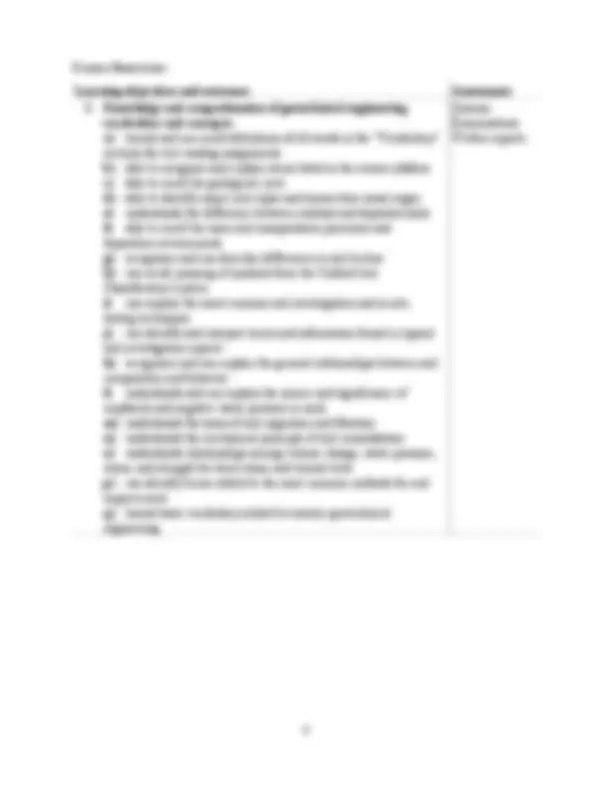
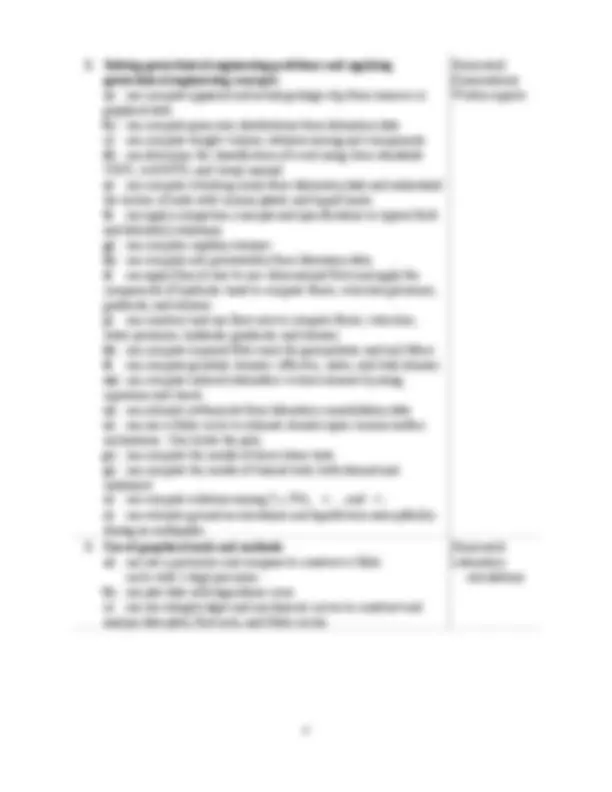
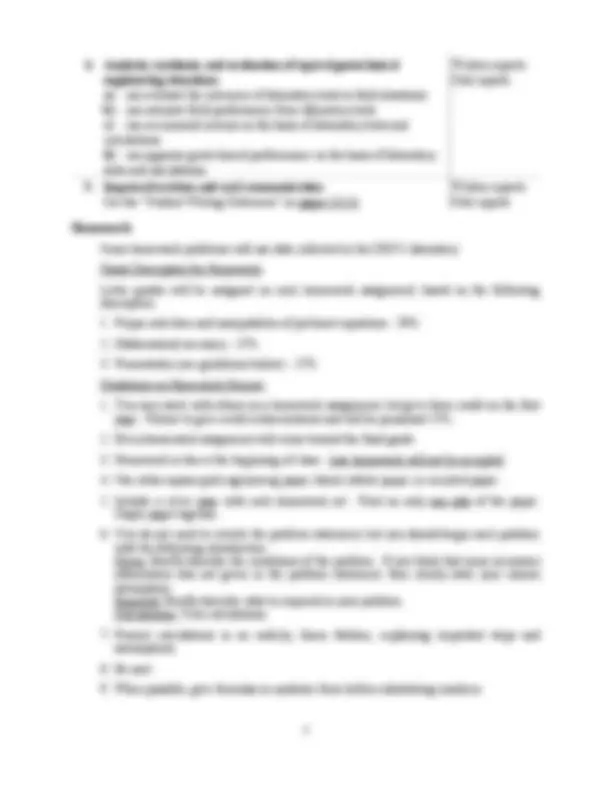
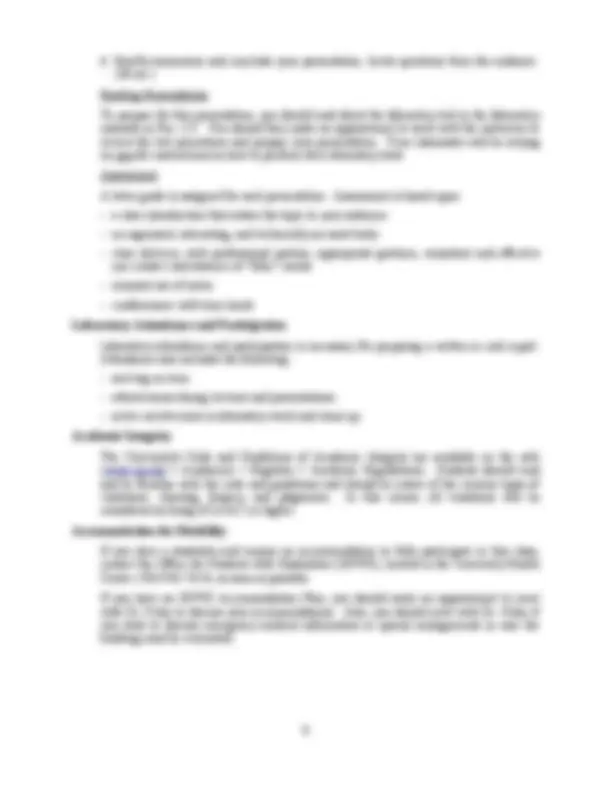
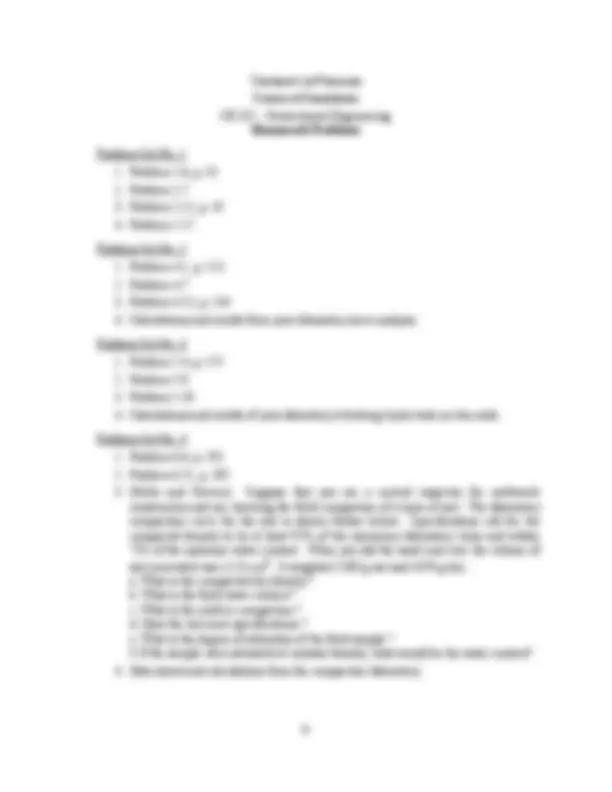
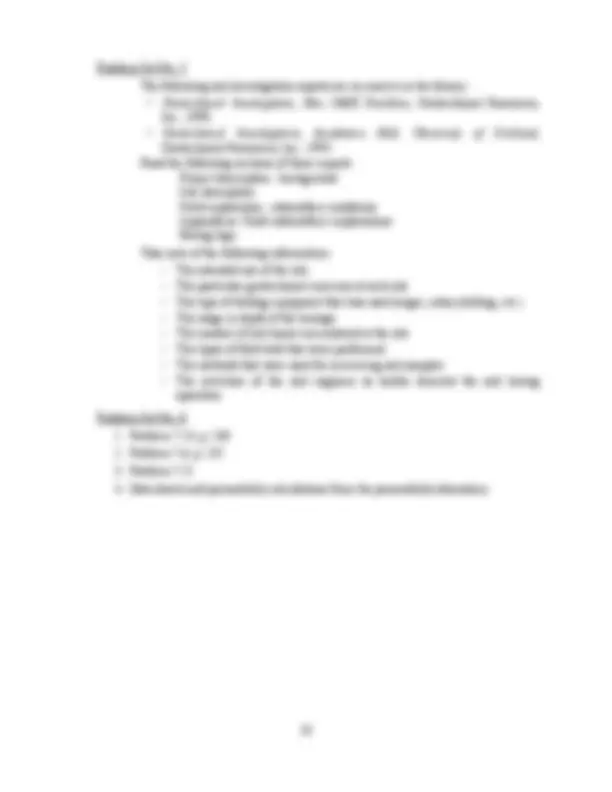
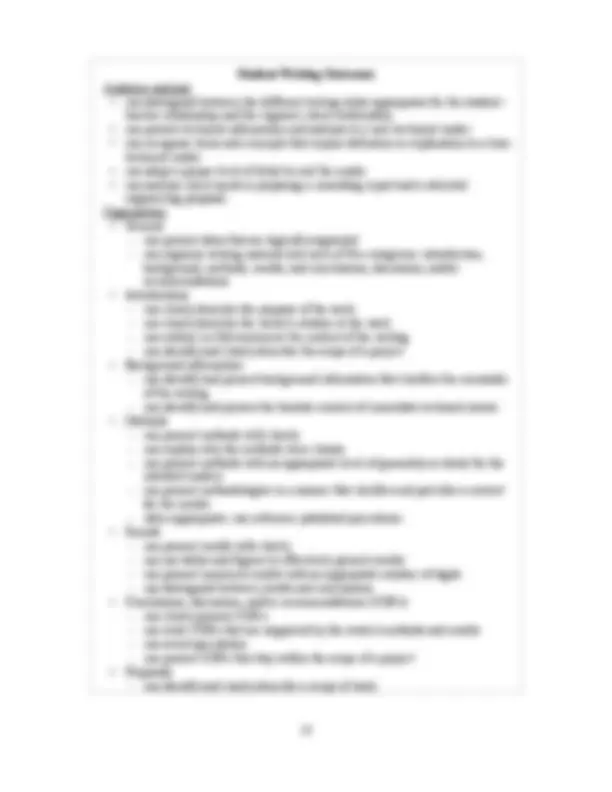
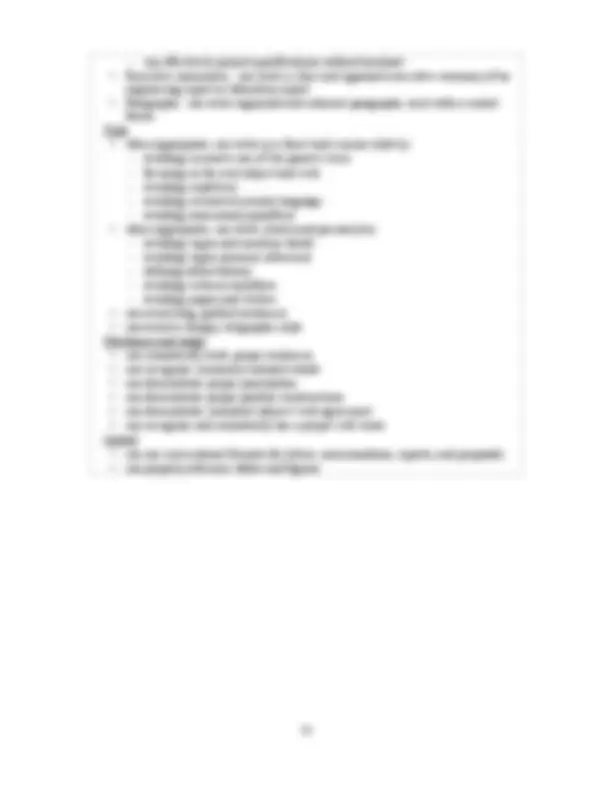
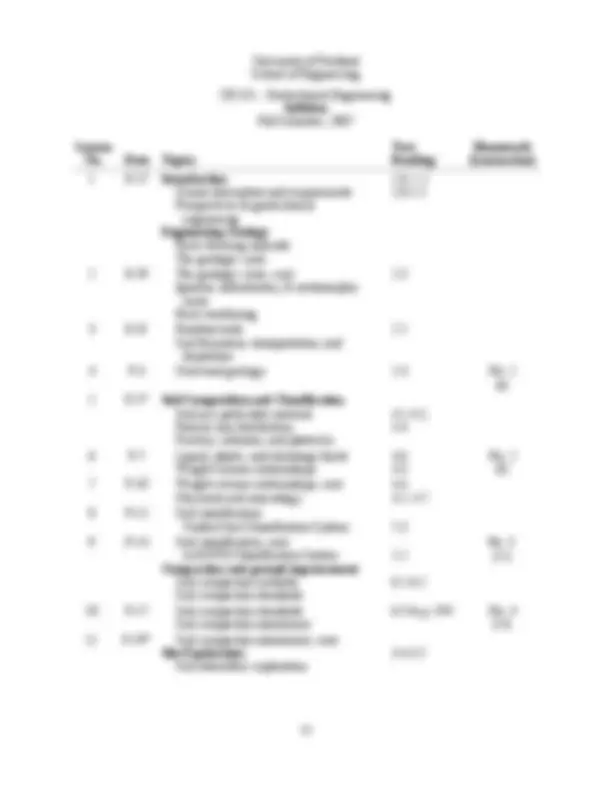
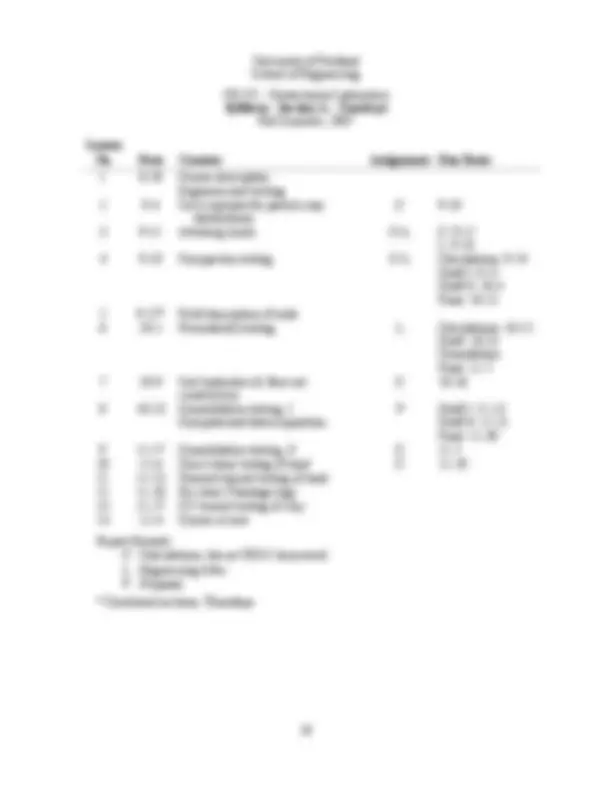
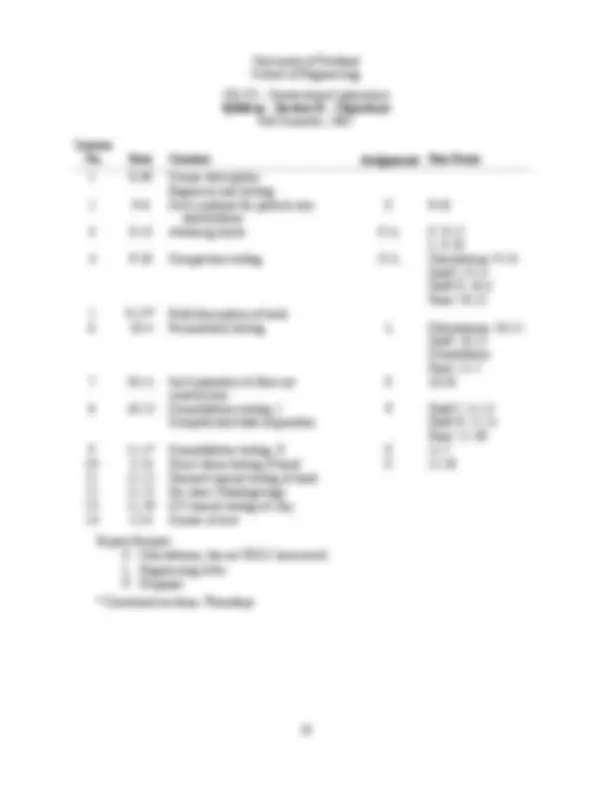


Study with the several resources on Docsity

Earn points by helping other students or get them with a premium plan


Prepare for your exams
Study with the several resources on Docsity

Earn points to download
Earn points by helping other students or get them with a premium plan
Community
Ask the community for help and clear up your study doubts
Discover the best universities in your country according to Docsity users
Free resources
Download our free guides on studying techniques, anxiety management strategies, and thesis advice from Docsity tutors
Material Type: Exam; Professor: Kuhn; Class: Geotechnical Engineering; Subject: Civil Engineering; University: University of Portland; Term: Fall 2007;
Typology: Exams
1 / 19

This page cannot be seen from the preview
Don't miss anything!












University of Portland
School of Engineering
CE 321 - Geotechnical Engineering (MWF 11:25-12:20)
CE 371 - Geotechnical Laboratory (T or R, 2:30 – 5:40)
Fall Semester, 2007
Instructor: Dr. Matthew R. Kuhn (Room 103, 943-7361, kuhn@up.edu)
Office Hours:
Text: Donald P. Coduto, Geotechnical Engineering: Principles and Practices , Prentice Hall,
Upper Saddle River, NJ, 1999.
No text is required for the laboratory course, but you may find the following books useful.
All are available in Rm. 125.
Hill, 1992.
Englewood Cliffs, N.J.: Prentice Hall, 1990.
Course Learning Objectives
to civil engineering applications.
apply the resulting data.
Course Prerequisite: EGR322, Strength of Materials.
Assessment Tools (Lecture) :
Homework (11), quizzes (6) 30 %
Examination 1 20 %
Examination 2 20 %
Final examination 30 %
Assessment Tools (Laboratory):
Writing assignments 75 %
Oral presentations (2 per student) 15 %
Attendance & participation 10 %
Overall Evaluation: Grading will be based upon the following descriptors:
“A" Denotes exceptional accomplishment:
mastery of vocabulary and concepts from text and lectures
demonstrated ability to consistently apply mathematics, science, and engineering
concepts to textbook problems and laboratory calculations
demonstrated ability to present easily understandable homework solutions
consistently presents assignments on time
insight in extending concepts to less common situations
insight in synthesizing concepts in this course with those from other courses
clear, concise, interesting and properly edited written reports with proper conclusions
and recommendations that demonstrate clear insight into the geotechnical issues.
“B" Denotes accomplishment significantly better than average:
thorough understanding of vocabulary and concepts from text and lectures
demonstrated ability to apply concepts to textbook problems
demonstrated ability to present understandable homework solutions
consistently presents assignments on time
clear, concise, interesting and properly edited written reports with proper conclusions
and recommendations
“C" Denotes satisfactory accomplishment:
knowledge of vocabulary and concepts from text and lectures demonstrated ability to
apply most concepts to textbook problems technical reports with proper conclusions
and recommendations
“D" Denotes accomplishment less than satisfactory but still passing
lacks either a knowledge of vocabulary and concepts or the demonstrated ability to
apply many concepts to textbook problems
poorly written reports that show little insight into the geotechnical issues
“F" Denotes failure.
less than 50% average score due to lack of the positive outcomes given above
Reading Assignments: You are expected to complete the reading assignments given in the
syllabus before the class period. The text material will be covered on examinations and
occasional quizzes.
2. Solving geotechnical engineering problems and applying
geotechnical engineering concepts:
a) can compute apparent and actual geologic dip from numeric or
graphical data
b) can compute grain size distributions from laboratory data
c) can compute weight–volume relations among soil components
d) can determine the classification of a soil using three standards:
USCS, AASHTO, and visual-manual
e) can compute Atterberg limits from laboratory data and understand
the texture of soils with various plastic and liquid limits
f) can apply compaction concepts and specifications to typical field
and laboratory situations
g) can compute capillary stresses
h) can compute soil permeability from laboratory data
i) can apply Darcy's law to one–dimensional flow and apply the
components of hydraulic head to compute flows, velocities,pressures,
gradients, and stresses
j) can construct and use flow nets to compute flows, velocities,
water pressures, hydraulic gradients, and stresses
k) can compute required filter sizes for geosynthetic and soil filters
l) can compute geostatic stresses: effective, water, and total stresses
m) can compute induced subsurface vertical stresses by using
equations and charts
n) can estimate settlements from laboratory consolidation data
o) can use a Mohr circle to estimate stresses upon various surface
inclinations. Can locate the pole.
p) can compute the results of direct shear tests
q) can compute the results of triaxial tests, both drained and
undrained
r) can compute relations among f, c, P/A, 1 , and 3
s) can estimate ground accelerations and liquefaction susceptibility
during an earthquake
Homework
Examinations
Written reports
3. Use of graphical tools and methods
a) can use a protractor and compass to construct a Mohr
circle with 2-digit precision
b) can plot data with logarithmic axes
c) can use straight edges and mechanical curves to construct and
analyze data plots, flow nets, and Mohr circles
Homework
Laboratory
calculations
4. Analysis, synthesis, and evaluation of typical geotechnical
engineering situations:
a) can evaluate the relevance of laboratory tests to field situations
b) can estimate field performance from laboratory tests
c) can recommend actions on the basis of laboratory tests and
calculations
d) can appraise geotechnical performance on the basis of laboratory
tests and calculations
Written reports
Oral reports
5. Improved written and oral communication
See the “Student Writing Outcomes" on pages 13-14.
Written reports
Oral reports
Homework:
Some homework problems will use data collected in the CE371 laboratory.
Grade Descriptors for Homework
Letter grades will be assigned on each homework assignment, based on the following
descriptors.
Guidelines on Homework Format:
page. Failure to give credit is discourteous and will be penalized 25%.
Staple pages together.
with the following introduction:
Given: Briefly describe the conditions of the problem. If you think that some necessary
information was not given in the problem statement, then clearly state your chosen
assumption.
Required: Briefly describe what is required in your problem.
Calculations: Your calculations.
assumptions.
proper and carefully constructed conclusions and recommendations
Writing quality (see pages 13-14):
proper organization and development
clear introduction
clear presentation of background material
clear and concise presentation of laboratory procedures
proper technical writing style
correct editing
Guidelines
electronic copy of each report. Reports handed in after the start of class will be
penalized 25%. Reports will not be accepted after 5:30 p.m.
appropriate.
grading sheet (if any) on top.
Laboratory Oral Reports
Each student will give two oral presentations: a debriefing on the results of the previous
week's laboratory test and a briefing on how to conduct a laboratory test.
Your presentations should be 6-8 minutes, not including time for audience questions.
Points will be deducted if your presentation is longer or shorter.
An overhead projector and screen will be available in the classroom. If you will be using
them, it is your responsibility to get them set up. If you need a slide projector, arrange this
with the instructor and the Instructional Media Center 2 to 3 days ahead (Library
basement).
You are encouraged to use “props" (material samples, testing equipment, etc.) during your
presentations.
Debriefing Presentations
You can use the following format for debriefing presentations:
credit to your laboratory partners, and briefly outline your presentation. (30 sec.)
general principle that is involved in its measurement, and the types of problems that the
test would be useful in analyzing. (1-2 min.)
laboratory tests. (2 min.)
to a design situation. (1-2 min.)
(30 sec.)
Briefing Presentations
To prepare for this presentation, you should read about the laboratory test in the laboratory
manuals in Rm. 125. You should then make an appointment to work with the instructor to
review the test procedures and prepare your presentation. Your classmates will be relying
on you for instructions on how to perform their laboratory tests.
Assessment
A letter grade is assigned for each presentation. Assessment is based upon:
eye contact, and absence of “filler" words
Laboratory Attendance and Participation
Laboratory attendance and participation is necessary for preparing a written or oral report.
Attendance also includes the following:
Academic Integrity
The University's Code and Guidelines of Academic Integrity are available on the web
(www.up.edu > Academics > Registrar > Academic Regulations). Students should read
and be familiar with the code and guidelines and should be aware of the various types of
violations: cheating, forgery, and plagiarism. In this course, all violations will be
considered as being of Level 2 or higher.
Accommodation for Disability
If you have a disability and require an accommodation to fully participate in this class,
contact the Office for Students with Disabilities (OSWD), located in the University Health
Center (503-943-7314), as soon as possible.
If you have an OSWD Accommodation Plan, you should make an appointment to meet
with Dr. Kuhn to discuss your accommodations. Also, you should meet with Dr. Kuhn if
you wish to discuss emergency medical information or special arrangements in case the
building must be evacuated.
Problem Set No. 5
The following soil investigation reports are on reserve in the library:
Inc., 1990.
Geotechnical Resources, Inc., 1993.
Read the following sections of these reports:
Project description - background
Site description
Field exploration - subsurface conditions
Appendices: Field (subsurface) explorations
Boring logs
Take note of the following information:
operation
Problem Set No. 6
Problem Set No. 7
figure below.
a. Sketch a set of flow and equipotential lines for the soil.
b. Derive an equation that gives the flow rate of seepage as a function of the slope
angle, q, and thickness, d.
Problem Set No. 8
problem.
Problem Set No. 9
a. Plot the void ratio, e , on a semi-logarithmic diagram. Choose an appropriate
extent for each axis.
b. Using Casagrande's method, find ^ ' c
c. Using Schmertmann's method, adjust the textbook data.
d. Determine C c
and C r
d
θ
Student Writing Outcomes
Audience analysis
teacher relationship and the engineer-client relationship
technical reader
engineering proposal
Organization
background, methods, results, and conclusions, discussion, and/or
recommendations
of the writing
intended readers
for the results
engineering report or laboratory report
theme
Style
Mechanics and usage
Layout
12 9-21 Soil subsurface exploration, cont. 3.6 to p.72,
(pp. 75-78)
No. 5
13 9-24 Groundwater and Soil Hydraulics
Groundwater hydrology concepts
Groundwater flow conditions
One–dimensional flow and Darcy's law
7.3 to p. 225
14 9-26* Head and pore water pressure
Hydraulic head and its components
7.3 No. 6
15 9-28 Soil hydraulics examples
Seepage velocity pp. 232-
16 10-1 Examination No. 1
17 10-3 Soil hydraulics examples
Flow nets
8.1 to p. 252 No. 7
18 10-5* Flow nets, cont.
19 10-8 Soil hydraulics examples
Soil migration and filtration
pp. 270-
20 10-10 Capillarity
Negative water pressure
p. 344-
21 10-12 Stresses within a soil mass
Geostatic stresses
Induced subsurface stresses
(parts of 10.5)
No. 8
22 10-22 Induced subsurface stresses, cont.
Effective stresses
23 10-24 Compressibility and Settlement
Settlement processes
Consolidation process
24 10-26 Consolidation process, cont.
Consolidation tests
No. 9
25 10-29 Preconsolidation stress
Reconstructed consolidation curve
26 10-31 Consolidation settlement predictions 11.5, 11.7 No. 10
27 11-2* Consolidation settlement predictions,
cont.
28 11-5 Shear strength of soils
Mohr's circle and the pole
Direct shear testing
pp. 500-
29 11-7 Direct shear testing, cont.
Shear failure in soils
Mohr-Coulomb failure criterion
13.3 to p.
No. 11
30 11-9 Shear strength of sands and gravels
Mohr-Coulomb failure criteria
31 11-12 Triaxial testing of sands pp. 504-
32 11-14 Examination 2
33 11-16 Triaxial testing of sands, cont. 13.5 to p.490 No. 12
34 11-19 Triaxial testing of sands, cont.
Shear strength of clays and silts
pp. 490-
35 11-21 UU testing and CU testing
36 11-26 Geotechnical earthquake engineering
Earthquake sources, intensities and
magnitudes
37 11-28 Site response
Liquefaction
38 11-30 Liquefaction, cont. 20.3 to p.
39 12-3* Liquefaction assessment pp. 695-
40 12-5 Ground improvement 19.1-19.
41 12-7 Course review and evaluation
Dec. 13 (Wednesday)
10:30-12:30 Final Examination
University of Portland
School of Engineering
CE 371 - Geotechnical Laboratory
Syllabus - Section B – Thursdays
Fall Semester, 2007
Lesson
No. Date Content (^) Assignment Due Dates
1 8-30 Course description
Engineers and writing
2 9-6 Sieve analysis for particle size
distributions
3 9-13 Atterberg limits C–L C: 9-
4 9-20 Compaction testing C–L Calculations: 9-
Draft I: 9-
Draft II: 10-
Final: 10-
5 9-27* Field description of soils
6 10-4 Permeability testing L Calculations: 10-
Draft: 10-
Consultation
Final: 11-
7 10-11 Soil hydraulics & flow net
construction
8 10-25 Consolidation testing, I
Computerized data acquisition
P Draft I: 11-
Draft II: 11-
Final: 11-
9 11-1* Consolidation testing, II C 11-
10 11-8 Direct shear testing of sand C 11-
11 11-15 Drained triaxial testing of sand
12 11-22 No class (Thanksgiving)
13 11-29 CU triaxial testing of clay
14 12-6 Course review
Report formats:
C - Calculations, due as CE321 homework
L - Engineering letter
P - Proposal